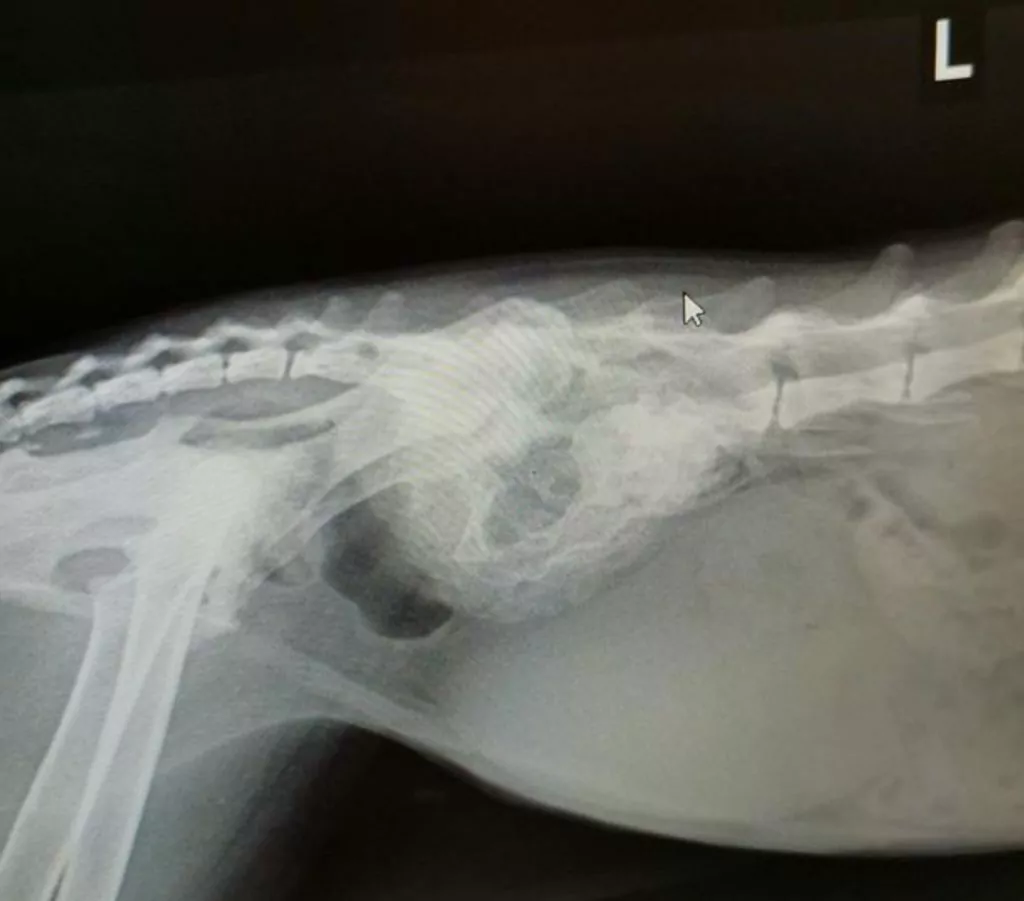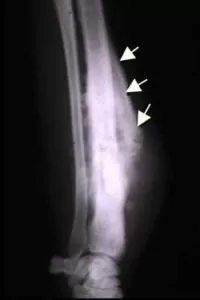Osteosarcomas in dogs and cats or bone tumors are masses of abnormal, uncontrollable cell growth within the bone. They can involve the axial skeleton (the spine, the ribs, the pelvis, the scapula, and the skull), or more often the appendicular skeleton (the limbs).

Bone tumors are classified as primary or secondary tumors. Primary tumors develop and arise in the bone, and secondary bone tumors have spread from adjacent tissue.
The most common bone tumors are osteosarcoma, fibrosarcoma, chondrosarcoma, and hemangiosarcoma.
Osteosarcomas
Osteosarcoma is a bone tumor that is malignant in nature and is the most common type of bone tumor among dogs and cats. In fact, osteosarcoma is the tumor identified in more than 95% of pets with bone cancer.
A specific cause for the occurrence of osteosarcoma hasn’t been found, but it is believed, that pets with some kind of previous bone damage are more at risk (fractures, radiation, bone diseases, orthopedic implants, or surgery).
It is very peculiar that this disease affects dogs and cats very differently. In dogs, osteosarcoma is an extremely aggressive malignant tumor, and meanwhile, in cats, it’s with benign characteristics and only in 3rd of the cases.
Osteosarcoma in Dogs

In dogs, osteosarcoma is the most common type of bone tumor. It affects dogs of all breeds, but the prevalence is higher in large breed dogs. Because the tumor is very aggressive by nature, it tends to metastasize very rapidly.
This rapid progression limits the treatment strategies, and the patients usually get an amputation of the affected limb (if the tumor is too big) followed by chemotherapy.
Symptoms of Osteosarcomas in Dogs
- Swelling of the affected bone followed by lameness if the tumor is located on one of the limbs
- Swelling or formation of a mass, if the tumor is located in the skull, the jaw or the ribs
- If the tumor is located in the jaw or nearby, the symptom may be difficulty eating or chewing
- If the tumor is located in the skull or the spine, neurological symptoms may be noticed
- With tumors located in the rib cage, difficulty breathing and lameness may be evident
- General lethargy, loss of appetite and weight loss
Osteosarcoma in Cats
Felines generally do not get bone cancers, but when they do, it is most likely to be osteosarcoma. In the cats that develop osteosarcomas, the tumor is benign in one-third of the affected cats.
When it comes to symptoms, in cats they are mostly confined to the area of the body where the tumor is located. For example, if the tumor is located on the left hind limb, the cat most likely will feel weakness only in that limb and will present no other symptom of trauma.
A symptom like swelling that is hard to the touch or pain may be evident.
How is Osteosarcomas Diagnosed in Dogs and Cats?
For starters, the veterinarian will take a detailed history of the patient with an emphasis on the onset of the symptoms. This will be followed by a thorough physical and orthopedic exam along with radiographic pictures of the affected area.
This is done in order to rule out any other possible causes for lameness or pain. If the x-rays suggest that there is some kind of growth or change in the bone, a biopsy is done in order to determine the cause.
If osteosarcoma is diagnosed, then the veterinarian will order chest x-rays or a CT to determine if the tumor metastasized or not. Osteosarcomas are tumors that have 90-95% of metastasizing, and usually to the lungs.
Treating Osteosarcomas in Dogs and Cats

If the tumor is localized to a limb, the usual treatment is amputation followed by aggressive chemotherapy to prevent metastasis. Amputation is not always an option for all pets, but usually, most pets that do not have other health issues (aside from osteosarcoma) live very well on three limbs.
When the tumor is located in a location that does not allow amputation, the best option for treatment is stereotactic radiosurgery. This is a type of radiation therapy with a very high accuracy that delivers very high doses of radiation in order to damage and kill the abnormal cell of the tumor.
Even with this treatment, chemotherapy is still necessary.
With all therapy protocols, it’s recommended to provide also palliative treatment to reduce the pain and to assure comfort to the pet.
The prognosis always depends on the location of the tumor and its severity. Survival rates are about one to three years after amputation or stereotactic radiosurgery. But some patients tend to surprise and beat the odds.
